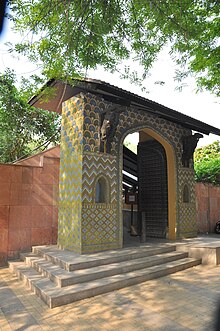National Handicrafts and Handlooms Museum, New Delhi
 |
|
| Established | 1956 |
|---|---|
| Location |
Pragati Maidan, Bhairon Road New Delhi, India |
| Coordinates | 28°36′49″N 77°14′32″E / 28.613551°N 77.24232°E |
| Website | nationalcraftsmuseum.nic.in/ |
The National Handicrafts and Handlooms Museum (NHHM) commonly known as National Crafts Museum in New Delhi is one of the largest crafts museums in India.
It is run by the Ministry of Textiles, Government of India. The museum is situated on the corner of the Pragati Maidan, facing the Purana Qila complex.
It was set up over a period of 30 years starting in the 1950s and 60s by the efforts of the renowned freedom fighter late Smt Kamaladevi Chattopadhyay, when the area was envisaged as an ethnographic space where craftsmen from various parts of India would come in to work towards preservation of various traditional arts and crafts. By the 1980s it already had a substantial collection, and in time the museum space gradually evolved and transformed into its present shape.
Today the museum holds over 35,000 rare and distinctive pieces reflecting the continuing tradition of Indian craftsmen through painting, embroidery, textiles, various crafts of clay, stone and wood, all housed in a building designed between 1975 and 1990 by architect Charles Correa, incorporating traditional architectural vocabulary into a modern design.
Various galleries within the museum include the Tribal and Rural Craft Gallery, Gallery of Courtly Crafts, Textile Gallery, Gallery of Popular Culture etc. Some of its prized collection include, the 250-300-year-old, Bhoota Collection from Karnataka, rare Kashmiri 300-year-old ‘dushalas’, handkerchiefs from Chamba, known for their unique embroidery, rare brocade and Baluchari saris, Kutch embroidery, precious metal jewellery and much more. The museum is popular for an exhaustive collection of textiles. The museum also houses a village complex spread over 5-acre (20,000 m2), with 15 structures representing village dwellings, courtyards and shrines from different states of India, with items of day-to-day life displayed. The entire village complex is a remnant of a temporary exhibition on the theme of rural India, held in 1972. Today several traditional craftsmen in residence at the museum, can be seen working in a designated area within the museum complex, who also sell the crafts they create.
...
Wikipedia
